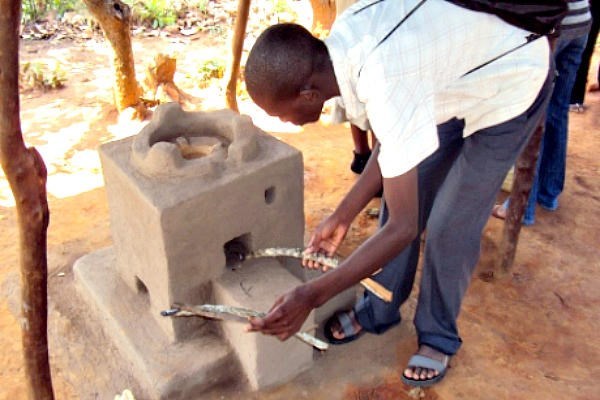 |
| A young man demonstrates how to insert wood into an Esperanza cooking stove in Malawi’s Rumphi North region. The locally produced stoves use less wood, saving forests and easing the lives of families. Karen Sanje/AlertNet |
RUMPHI, MALAWI
Collida Harawa has spent a lot of her life gathering firewood. Like most villagers in the hilly district of Rumphi in northern Malawi, the 39-year-old peasant farmer relies on it as the only freely available fuel for cooking.
But collecting fuel is time-consuming and tiring. Harawa must walk up to seven kilometers (more than four miles) to the forest to fetch firewood, which she ties into a big bundle and carries the same distance home on her head.
And over time, the environmental consequences of fuel wood consumption have become clear, as Malawi's forest cover dwindles and carbon emissions rise.
But now Harawa and villagers like her are taking advantage of a new kind of cooking stove, made from locally available materials, that requires much smaller volumes of fuel than traditional stoves.
By doing so, they are not just saving themselves time and effort but are also helping to reduce emissions of carbon dioxide, which scientists say contributes to climate change.
The new brick and ceramic stove cuts use of wood fuel by up to 65 percent, according to John Bwati Gondwe, coordinator of the Esperanza stove project at the Eva Demaya Center, a local nongovernmental organization.
"That means a lot as far as protecting forests and reducing carbon emissions are concerned," he said.
Trees use and store carbon dioxide during photosynthesis, and cutting them can not only increase carbon emissions but also disrupt the rainmaking process, called evapo-transpiration.
That leads to drier and more extreme weather conditions, which is harmful for agriculture and can increase the risk of weather-related disasters.
The Esperanza stove is a chamber made from materials such as bricks which are locally made from dried soil. The chamber contains six to eight ceramic rings, depending on the size of the stove. The rings are also made locally.
When a fire is set in the stove chamber, the rings quickly absorb and retain heat.
"They are heated even with fire made with very little amounts of wood," Gondwe said.
"Once the ceramic rings are fired up, the chamber starts absorbing some of the heat from them and stores it as the small amounts of wood burn," he explained.
When the fire goes out, the chamber will remain sufficiently hot to cook food, as the ceramic rings transmit sustained heat to the cooking vessel above them.
The ceramic ring technology was developed in Canada, but the Esperanza stove is a local invention. The Eva Demaya Center began distributing the stoves in Rumphi in late 2011 and has so far given out 750 of them. In total, Gondwe said, the project is targeting up to 10,000 households.
Each stove costs 2,500 Malawian kwachas (about $10), a subsidized price that mainly covers the cost of installation.
"With sufficient funding, the project can be replicated anywhere in the country. We have those plans to extend to other areas of the country but we are restricted by insufficient funding," Gondwe added.
According to a World Bank report released in 2011, about a third of Malawi is forested with either indigenous of exotic trees. But the country is fast losing its remaining native primary forest, with losses between 2000 and 2005 estimated at about 35 percent by forestry organizations.
Domestic cooking is the primary use for wood, but trees are also felled to clear land for agriculture, and wood is also used to fuel kilns that make bricks for building.
Villagers mainly target native trees for fuel. Benita Mbewe, of Rumphi North, says the high quality of wood from natural trees yields a more efficient fire than exotic species.
But since adopting the Esperanza stove, Mbewe has been using less wood, and finding other advantages too.
"I now have more time to perform other chores like gardening and attending to some income-generating activities such as taking part in some public works projects," she said.
Page created on 8/28/2012 12:00:00 AM
Last edited 8/28/2012 12:00:00 AM
• This article originally appeared at AlertNet, the Thomson Reuters Foundation humanitarian news service.
